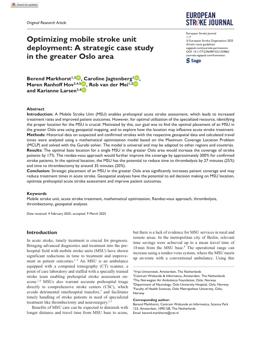2025-03-27
Optimizing mobile stroke unit deployment: A strategic case study in the greater Oslo area
Publication
Publication
European Stroke Journal p. 1- 7
Introduction: A Mobile Stroke Unit (MSU) enables prehospital acute stroke assessment, which leads to increased treatment rates and improved patient outcomes. However, for optimal utilization of the specialized resource, identifying the proper location for the MSU is crucial. Motivated by this, our goal was to find the optimal placement of an MSU in the greater Oslo area using geospatial mapping, and to explore how the location may influence acute stroke treatment. Methods: Historical data on suspected and confirmed strokes with the respective geospatial data and calculated travel times were analyzed using a mathematical optimization model based on the Maximum Coverage Location Problem (MCLP) and solved with the Gurobi solver. The model is universal and may be adapted to other regions and countries. Results: The optimal base location for a single MSU in the greater Oslo area would increase the coverage of stroke patients by 17%. The rendez-vous approach would further improve the coverage by approximately 300% for confirmed stroke patients. In the optimal location, the MSU has the potential to reduce time to thrombolysis by 27 minutes (25%) and time to thrombectomy by around 35 minutes (20%). Conclusion: Strategic placement of an MSU in the greater Oslo area significantly increases patient coverage and may reduce treatment times in acute stroke. Geospatial analyses have the potential to aid decision making on MSU location, optimize prehospital acute stroke assessment and improve patient outcomes.
| Additional Metadata | |
|---|---|
| , , , , , , | |
| doi.org/10.1177/23969873251329862 | |
| European Stroke Journal | |
| Organisation | Centrum Wiskunde & Informatica, Amsterdam (CWI), The Netherlands |
|
Markhorst, B., Jagtenberg, C., Hov, M. R., van der Mei, R., & Larsen, K. (2025). Optimizing mobile stroke unit deployment: A strategic case study in the greater Oslo area. European Stroke Journal, 1–7. doi:10.1177/23969873251329862 |
|

